

|
The following are four songs ranging in dates from 1876 to 1917 having some relationship with Mark Twain and his works. They are entitled, “Punch! Brothers, Punch!” “The Mark Twain Mazurka,” “The Huckleberry Finn Cakewalk” and “Huckleberry Finn.” Spanning both popular and classical genres of the time, these songs give some insight into how Mark Twain’s work and image were received by his contemporary culture, particularly the musical world. The songs are all fairly lighthearted and humorously nostalgic. |
|
|
|
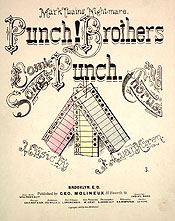 |
Punch! Brothers Punch! Music by J.A. Kuren. Supplementary words by R.E. O’Brien. Brooklyn: Geo. Molineux, 1876. The words to this short waltz came from a short story with the same name published by Mark Twain, in which a little newspaper jingle haunts him because he is unable to erase it from his head. The cover art proclaims it to be “Mark Twain’s Nightmare,” which apparently led many people to believe that the words were written by Mark Twain himself. However, two editorials in the New York Times were devoted to clarifying that Mark Twain never wrote – and never tried to say that he wrote – the jingle himself. Interestingly, the editorials appeared in 1915 –
on August 3 and August 8. This was
five years after the death of Samuel Clemens, proving that the song and the story were still garnering the interest and enthusiasm of the public. The words of the jingle were actually written by Isaac Bromley, Noah Brooks, W.C. Wyckoff, and Moses W. Handy. 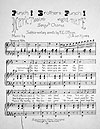
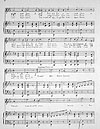
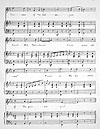
|
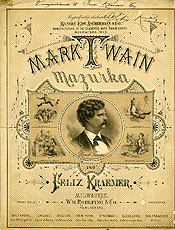 |
Mark Twain Mazurka By Felix Kraemer. Milwaukee: Wm. Rohlfing & Co 1880. A mazurka is a type of Polish folk dance characterized by three-quarter time. The second beat of the measure is usually the strong beat of each measure.* They became popular in America beginning in the 1840s, particularly because Frédéric Chopin made them famous by publishing fifty-eight.*
Written in three-quarter time, with a very pronounced second beat, this song is very typical of mazurkas. Although it is certainly entertaining, the song itself really has very little to do with Mark Twain. 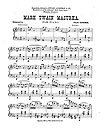
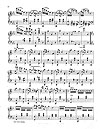
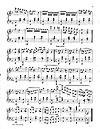
|
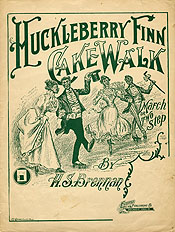 |
Huckleberry Finn Cakewalk By H. S. Brennan. Philadelphia: Jos. Morris, 1900. The cakewalk, a dance in which the winner received a cake, was believed to have originated on Southern plantations by African-American slaves. Later, it was popularized in blackface minstrel shows, vaudeville and burlesque and white audiences watched it performed. There were no specific steps to the dance, although it was performed in a promenade-style with marching and grandiose motions, meant to parody the white plantation owners’ stiff dancing style.* 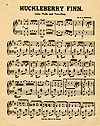
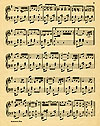
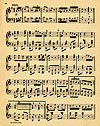
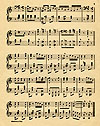
|
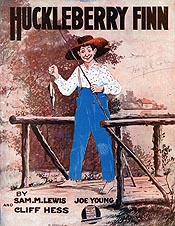 |
Huckleberry Finn By Cliff Hess, Sam M. Lewis and Joe Young. New York: Waterson, Berlin and Snyder Co, 1917 The latest of these songs, “Huckleberry Finn” expresses a nostalgic desire to return to childhood and particularly to boyhood – which is why it is so interesting that the piece itself is written in the treble clef, most easily sung by a female. A man would have to sing an octave lower than what is written. Furthermore, these kinds of songs were written for private usage, and were most likely played by women, who were often taught the basics of piano and voice. (Note the hand-written name on the cover, “Hazel Cole,” presumably the woman or girl who originally owned the music.) 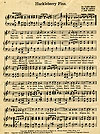
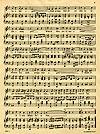
|
|
In conclusion, these songs give the listener an idea of what Mark Twain’s contemporary audience thought of him and of his work. Certainly one might get some idea of what his audience thought of him by looking at contemporary critical reviews of his work. But critics are not the general public, and it is often the case that the two groups often have different ideas about the same works.  |